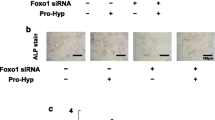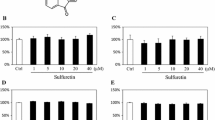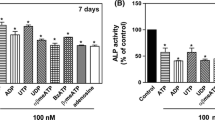Abstract
Polyphosphate [Poly(P)] has positive effects on osteoblast mineralization; however, the underlying mechanism remains unclear. In addition, it is unknown whether Poly(P) promotes mineralization in soft tissues. We investigated this by using various cells. Poly(P) concentrations of 1 and 0.5 mg/mL yielded high levels of mineralization in ROS17/2.8 osteoblast cells. Similarly, Poly(P) induced mineralization in cell types expressing alkaline phosphatase (ALP), namely, ATDC5 and MC3T3-E1, but not in CHO, C3H10T1/2, C2C12, and 3T3-L1 cells. Furthermore, forced expression of ALP caused Poly(P)-induced mineralization in CHO cells. These results suggest that ALP determines Poly(P)-induced mineralization in a cell-type independent manner.








Similar content being viewed by others
References
Kajander T, Kellosalo J, Goldman A (2013) Inorganic pyrophosphatases: one substrate, three mechanisms. FEBS Lett 587:1863–1869
Kulaev IS, Vogabov VM, Kulakovskaya T (1999) New aspects of inorganic polyphospate metabolism and function. J Biosci Bioeng 88:111–129
Moreno SN, Docampo R (2013) Polyphosphate and its diverse functions in host cells and pathogens. PLoS Pathog 9:e1003230
Kumble KD, Kornberg A (1995) Inorganic polyphosphate in mammalian cells and tissues. J Biol Chem 270:5818–5822
Leyhausen G, Lorenz B, Zhu H, Geurtsen W, Bohnensack R, Müller WE, Schröder HC (1998) Inorganic polyphosphate in human osteoblastlike cells. J Bone Miner Res 13:803–812
Schröder HC, Kurz L, Muller WEG, Lorenz B (2000) Polyphosphate in bone. Biochem 65:353–361 (Moscow)
Orimo H (2010) The mechanism of mineralization and the role of alkaline phosphatase in health and disease. J Nippon Med Sch 77:4–12
Usui Y, Uematsu T, Uchihashi T, Takahashi M, Takahashi M, Ishizuka M, Doto R, Tanaka H, Komazaki Y, Osawa M, Yamada K, Yamaoka M, Furusawa K (2010) Inorganic polyphosphate induces osteoblastic differentiation. J Dent Res 89:504–509
Kawazoe Y, Shiba T, Nakamura R, Mizuno A, Tsutsumi K, Uematsu T, Yamaoka M, Shindoh M, Kohgo T (2004) Induction of calcification in MC3T3-E1 cells by inorganic polyphosphate. J Dent Res 83:613–618
Ariganello MB, Omelon S, Variola F, Wazen RM, Moffatt P, Nanci A (2014) Osteogenic cell cultures cannot utilize exogenous sources of synthetic polyphosphate for mineralization. J Cell Biochem 115:2089–2102
Murshed M, McKee MD (2010) Molecular determinants of extracellular matrix mineralization in bone and blood vessels. Curr Opin Nephrol Hypertens 19:359–365
Partridge NC, Alcorn D, Michelangeli VP, Ryan G, Martin TJ (1983) Morphological and biochemical characterization of four clonal osteogenic sarcoma cell lines of rat origin. Cancer Res 43:4308–4314
Mikami Y, Ishii Y, Watanabe N, Shirakawa T, Suzuki S, Irie S, Isokawa K, Honda MJ (2011) CD271/p75(NTR) inhibits the differentiation of mesenchymal stem cells into osteogenic, adipogenic, chondrogenic, and myogenic lineages. Stem Cells Dev 20:901–913
Mikami Y, Somei M, Tsuda H (2011) SSH-BM-I, a tryptamine derivative, stimulates mineralization in terminal osteoblast differentiation but inhibits osteogenesis of pre-committed progenitor cells. J Pharmacol Sci 116:63–72
Mikami Y, Lee M, Irie S, Honda MJ (2011) Dexamethasone modulates osteogenesis and adipogenesis with regulation of osterix expression in rat calvaria-derived cells. J Cell Physiol 226:739–748
Majeska RJ, Rodan SB, Rodan GA (1991) Parathyroid hormone-responsive clonal cell lines from rat osteosarcoma. Endocrinology 107:1494–1503
Atsumi T, Miwa Y, Kimata K, Ikawa Y (1990) A chondrogenic cell line derived from a differentiating culture of AT805 teratocarcinoma cells. Cell Differ Dev 30:109–116
Kodama H, Amagai Y, Sudo H, Kasai S, Yamamoto S (1981) Establishment of a clonal osteogenic cell line from newborn mouse calvaria. Jpn J Oral Biol 23:899–901
Taylor SM, Jones PA (1979) Multiple new phenotypes induced in 10T1/2 and 3T3 cells treated with 5-azacytidine. Cell 17:771–779
Yaffe D, Saxel O (1977) A myogenic cell line with altered serum requirements for differentiation. Differentiation 7:159–166
Green H, Kehinde O (1975) An established preadipose cell line and its differentiation in culture. II. factors affecting the adipose conversion. Cell 5:19–27
Katagiri T, Yamaguchi A, Komaki M, Abe E, Takahashi N, Ikeda T, Rosen V, Wozney JM, Fujisawa-Sehara A, Suda T (1994) Bone morphogenetic protein-2 converts the differentiation pathway of C2C12 myoblasts into the osteoblast lineage. J Cell Biol 127(6 Pt 1):1755–1766
Cho YD, Yoon WJ, Kim WJ, Woo KM, Baek JH, Lee G, Ku Y, van Wijnen AJ, Ryoo HM (2014) Epigenetic modifications and canonical wingless/int-1 class (WNT) signaling enable trans-differentiation of nonosteogenic cells into osteoblasts. J Biol Chem 289:20120–20128
Yang D, Okamura H, Nakashima Y, Haneji T (2013) Histone demethylase Jmjd3 regulates osteoblast differentiation via transcription factors Runx2 and osterix. J Biol Chem 288:33530–33541
Ducy P, Zhang R, Geoffroy V, Ridall AL, Karsenty G (1997) Osf2/Cbfa1: a transcriptional activator of osteoblast differentiation. Cell 89:747–754
Doherty TM, Asotra K, Fitzpatrick LA, Qiao JH, Wilkin DJ, Detrano RC, Dunstan CR, Shah PK, Rajavashisth TB (2003) Calcification in atherosclerosis: bone biology and chronic inflammation at the arterial crossroads. Proc Natl Acad Sci USA 100:11201–11206
Medici D, Olsen BR (2012) The role of endothelial-mesenchymal transition in heterotopic ossification. J Bone Miner Res 27:1619–1622
Batt AM, Ferrari L (1995) Manifestations of chemically induced liver damage. Clin Chem 41:1882–1887
Ruiz FA, Lea CR, Oldfield E, Docampo R (2004) Human platelet dense granules contain polyphosphate and are similar to acidocalcisomes of bacteria and unicellular eukaryotes. J Biol Chem 279:44250–442757
Acknowledgments
This work was supported in part by the Sato Fund, Nihon University School of Dentistry (2010), a Strategic Research Base Development Program for Private Universities from the Ministry of Education, Culture, Sports, Science and Technology of Japan, 2010-2014 (S1001024) and a Nihon University Joint Research Grant (2012).
Author information
Authors and Affiliations
Corresponding author
Ethics declarations
Conflict of interest
All the authors have no commercial associations that might pose as a conflict of interest in connection with the manuscript.
Electronic supplementary material
Below is the link to the electronic supplementary material.
Supplemental Fig. 1. Effects of Poly(P) on the expression of osteogenic genes in CHO, C3H10T1/2, C2C12, 3T3-L1, ATDC5, and MC3T3-E1 cells. Cells were cultured with or without Poly(P) (1 mg/mL) in mineralization medium for 14 days. Thereafter, mRNA expression of osteogenic transcription factors (Runx2 and osterix) and osteoblast markers (bone sialoprotein (BSP), osteocalcin (OCN), and collagen type I (Col.I)) was analyzed by RT-PCR.
About this article
Cite this article
Mikami, Y., Tsuda, H., Akiyama, Y. et al. Alkaline phosphatase determines polyphosphate-induced mineralization in a cell-type independent manner. J Bone Miner Metab 34, 627–637 (2016). https://doi.org/10.1007/s00774-015-0719-6
Received:
Accepted:
Published:
Issue Date:
DOI: https://doi.org/10.1007/s00774-015-0719-6




